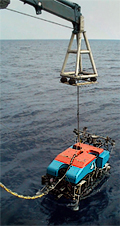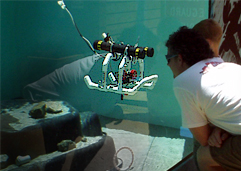Deep water archaeology
When you can't be there
When you can't be there
 Launching an ROV.
Launching an ROV.Image courtesy
DeepArch at MIT.
In most cases, you can't bring up an entire shipwreck, so you need to study it where it lies. This presents a number of tough challenges--the kind that researchers at MIT's Deep Water Archaeology Research Group (DeepArch) love to tackle.
MIT scientists such as David Mindell and his team use specialized technologies to "see" buried shipwrecks that lie under the sea floor. They use underwater robots to do survey and excavation work that divers could have done in shallower water. To see where their own eyes can't, through sediment, they use an instrument called the sub-bottom profiler.
They use "remotely operated vehicles", or ROVs for short, to carry instruments to the seafloor to take a look. They launch, pilot and track their ROV by remote-control from a control room aboard a ship. ROVs allow people to conduct work that would have been otherwise impossible because of unsafe conditions or some other problem that made it impossibile to send people.
Since each project has special needs, scientists continually develop new tools to carry out new and sometimes daunting tasks.
In the case of underwater archaeology, one of existing challenges is knowing the precise location of the ROV when it sees an artifact. In shallow water, divers can locate an object down to a centimeter. Is it possible to make such precise measurements using an ROV? Mindell's team has developed technologies that make the same standards of precision navigation available to the ROV-based excavations.
 Piloting the ROV in the ROV Testing Tank at the Ocean Institute.
Piloting the ROV in the ROV Testing Tank at the Ocean Institute.Image from the Ocean Institute.
All that you can do at OI
Students can build and test their own underwater robots during the Sea Floor Explorer middle school program.
Public visitors to the Institute get to test their piloting skills while driving student-made ROV's (remotely operated vehicles).
Where to find more information:
DeepArch
Learn more about the deepwater underwater archaeological investigations conducted by the MIT Deep Water Archaeology Research Group.
MIT
Remotely Operated Vehicles
Not all remotely operated vehicles (ROVs) can go underwater. Learn more about submersible ROVs.
NOAA Ocean Explorer
Sub-bottom Profilers
Coming soon from Earthguide.
Earthguide
Produced in collaboration with Scripps Institution of Oceanography.
Website by Earthguide.
© 2003-2004 by the Ocean Institute
and the Regents of the University of California.
All rights reserved.
Last modifed Monday, December 10, 2004
